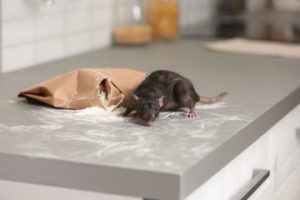Preventative measures can help reduce rodent attraction. Store firewood off the ground, remove overhanging branches, and trim vegetation. Keep trash cans secure and dispose of them regularly. Store food in sealed containers and wipe up crumbs promptly.
Professional Rodent Retreat technicians conduct thorough inspections and identify potential entry points. These are then sealed with caulk, weather stripping, or metal flashing.

Non-lethal Traps
Using humane traps can be an effective and more sustainable alternative to rodenticides. However, they are best suited to smaller infestations and can require a considerable amount of effort and monitoring.
Snap, glue, and live traps are all effective in catching rodents. They can be used indoors or outdoors and are usually placed along walls, near droppings and gnaw marks. They are typically baited with a small amount of food that the rats or mice will find attractive. Some are designed to kill the animal instantly when triggered, while others allow you to capture and release the rodents elsewhere. You can also use electrocution traps, which are enclosed devices that shut when a rodent enters and sends a high-voltage charge through metal plates to kill it.
Other methods of controlling the population include using natural repellents and deterrents, removing hiding sites around homes, barns, and garages, and eliminating potential nesting sites by trimming trees, weeds, and overgrown vegetation. You can also encourage the presence of natural predators such as owls by providing water, food, and shelter.
As a long-term solution, we offer pest exclusion services that are more effective at preventing rodents from accessing your home or business. We seal entry points using steel wool and caulk and can install wire mesh around crawl space vents, foundation openings, and any other exterior entry points that may need it.
Exclusion techniques
Rodents are persistent pests that can breed quickly, so it is important to take steps to prevent their access to food, water, and shelter. Mice and rats can squeeze through openings as small as a quarter inch, so it is important to seal any areas they could enter into the home.
To reduce rodent attraction, regularly clean indoor areas to eliminate food sources and nesting sites. Wipe down countertops, sweep floors, and vacuum carpeting to remove crumbs, hairs, and other debris. Store food in airtight containers and trash cans with lids that latch shut to deter scavenging rodents.
Outside the house, trim trees and shrubs to minimize the potential for them to provide hiding spots or ladders into the home. Keep weeds and brush trimmed back from the house, and do not store firewood against the foundation. Keep compost piles and yard waste away from the house, and don’t plant ivy close to walls where it can form “rat ladders.”
Regularly inspect the exterior of the home for signs of rodent activity, including droppings and gnaw marks, every month. This will help to catch infestations in their early stages and allow homeowners to seal entry points before they cause major problems. If a rodent infestation is detected, use exclusion techniques to seal any holes and cracks with caulking, spray foam, copper mesh, wire wool, metal screens, or hardware cloth.
Natural Repellents
Natural repellents utilize essential oils, herbs, spices, and natural minerals to deter rodents from entering homes. Peppermint oil, for example, has a strong scent that is unpleasant to rats. Mixing the oil with water and spraying it in areas of the home that are infested can keep them away. Similarly, the spice cayenne pepper can be effective as it irritates rats and makes them uncomfortable in a space. Garlic and onion also act as natural deterrents because of their pungent odor.
Other popular natural deterrents include eucalyptus oil and baking soda. Eucalyptus oil is effective because it disrupts the sense of smell that rodents use to navigate spaces. Soaking cotton balls in peppermint oil and placing them around vulnerable points of entry can also deter these pests. Other natural substances like salt, ammonia, and vinegar also work as effective rat repellents when mixed with water or applied to a cloth and placed near entry points or infested areas.
However, these home remedies are only effective for mild and early-stage infestations. Rodents are highly adaptable and can quickly learn to ignore these deterrents if they become familiar with them. For long-term results, professional exclusion services are necessary. These specialists can inspect the property and identify potential entry points before sealing them off with durable materials. In addition, preventive measures such as reducing clutter and securing garbage bins help to make the home less attractive to rats.
Call the Experts
Rodent infestations aren’t just a nuisance, but can also cause significant damage. From chewing through wires to destroying wood and insulation, they create serious health and safety risks and affect property value over time. Unlike store-bought traps and poison, professional pest control services target the entire rodent population while addressing their food sources and entry points.
Rodents can be carriers of severe and deadly diseases, including hantavirus, salmonella, monkeypox, leptospirosis, and typhus. These pathogens can be spread through rodent urine and feces, or by handling dead rodents. Regular inspections and prompt action can help prevent these threats, protecting you, your family, and your pets from the dozens of diseases they carry.
You can also reduce the chances of rodents finding their way into your home by identifying and sealing entry points. Look for small cracks and gaps in foundations, soffits, rooflines, vents, chimneys, and around doors and windows. Rodents are masters at slipping through gaps the size of a dime, so don’t ignore even the smallest holes. Also, make sure that trash is regularly disposed of in sealed bins and that pet food is stored in airtight containers. Lastly, clean up spills and crumbs promptly to eliminate potential food sources for rats and mice.
